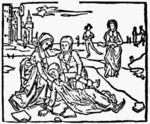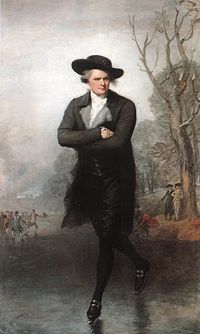Ice skating
2008/9 Schools Wikipedia Selection. Related subjects: Recreation
Ice skating is traveling on ice with skates, narrow (and sometimes parabolic) blade-like devices moulded into special boots (or, more primitively, without the boots, tied to regular footwear). People usually skate on frozen rivers and lakes and at skating rinks. It is mainly done for recreation and as a sport. Many musicals like Starlight Express have been performed on ice.
History
The exact time and process by which humans first learned to ice skate is not known, though archaeologists believe the activity was widespread. The convenience and efficiency of ice skating to cross large, icy areas is shown in archaeological evidence by the finding of primitive animal bone ice skates in places such as Russia, Scandinavia, Great Britain, the Netherlands, Germany, and Switzerland. The runners were made from bones of animals such as horse, cattle and reindeer. They were ground down until they formed a flat gliding surface, and thongs tied them to the feet. The skates were not used like contemporary skates. Instead they were used by straddling a pole which was used to push the user along. While only averaging 2.5 mph (4 kph) it used far less energy than trying to walk across frozen lakes. By comparison, modern skates use only about 25% of the energy of these primitive bone skates. Another study by Federico Formenti of the University of Oxford suggests that the earliest ice skating happened in Southern Finland some 4000 years ago.
Earliest historical documentation
The first concrete mention of ice skating is found in a biography of Thomas Becket written by his former clerk William Fitzstephen in about 1180. The book includes a description of London, with its popular sports.
When the great marsh that laps up against the northern walls of the city is frozen, large numbers of the younger crowd go there to play about on the ice... Others are more skilled at frolicking on the ice: they equip each of their feet with an animal's shin-bone, attaching it to the underside of their footwear; using hand-held poles reinforced with metal tips, which they periodically thrust against the ice, they propel themselves along as swiftly as a bird in flight or a bolt shot from a crossbow. But sometimes two, by accord, beginning far apart, charge each other from opposite directions and, raising their poles, strike each other with them. One or both are knocked down, not without injury, since after falling their impetus carries them off some distance and any part of their head that touches the ice is badly scratched and scraped. Often someone breaks a leg or an arm, if he falls onto [the ice].
The sticks that Fitzstephen refers to were used for movement, as the primitive bone-made ice skates did not have sharp gliding edges like modern ice skates.
The first depiction of ice skating in a work of art was made in the 15th century. The picture of Saint Lidwina, patron saint of ice skaters, falling on the ice, is included as an illustration in the 1498 edition of Lidwina's vita by Dutch franciscan John Brugman. It was the first work of art to feature ice skating as a main theme. Another important aspect of the painting is a man seen in the background who is skating on one leg. This means that the ice skates the man was wearing must have sharp edges similar to those found on modern ice skates.
Development of skates
Adding edges to ice skates was invented by the Dutch in the 13th or 14th century. These ice skates were made of steel, with sharpened edges on the bottom to aid movement. The construction of modern ice skates has remained largely the same. The only other major change in ice skate design came soon after. Around the same time period as steel edges were added to ice skates, another Dutchman, a table maker’s apprentice, experimented with the height to width ratio of the metal blade of the ice skates, producing a design that remains almost unaltered to this day. The user of the skates no longer needed to use sticks for propulsion, and movement on skates was now given more freedom and stability.
Social status of ice skating
In the Netherlands, ice skating was considered proper for all classes of people to participate in, as shown in many pictures by the Old Masters. However, in other places, participation in ice skating was limited to members of the upper classes. Emperor Rudolf II of the Holy Roman Empire enjoyed ice skating so much he had a large ice carnival constructed in his court in 1610 in order to popularize the sport. James II of England came to the Netherlands in exile, and he fell for the sport. When he went back to England, this "new" sport was introduced to the British aristocracy. King Louis XVI of France brought ice skating to Paris during his reign. Madame de Pompadour, Napoleon I, Napoleon III, and the House of Stuart were, among others, royal and upper class fans of ice skating. It is said that Queen Victoria got to know her future husband, Prince Albert, better through a series of ice skating trips.
How it works
Ice skating works because the metal blade at the bottom of the ice skate shoe can glide with very little friction over the surface of the ice. However, slightly leaning the blade over and digging one of its edges into the ice ("rockover and bite") gives skaters the ability to increase friction and control their movement at will. In addition, by choosing to move along curved paths while leaning their bodies radially and flexing their knees, skaters can use gravity to control and increase their momentum. They can also create momentum by pushing the blade against the curved track which it cuts into the ice. Skillfully combining these two actions of leaning and pushing— a technique known as "drawing"— results in what looks like effortless and graceful curvilinear flow across the ice.
Experiments show that ice has a minimum kinetic friction at −7°C (19° F), and many indoor skating rinks set their system to a similar temperature. The low amount of friction actually observed has been difficult for physicists to explain, especially at lower temperatures. On the surface of any body of ice at a temperature above about −20° C (−4° F), there is always a thin film of liquid water, ranging in thickness from only a few molecules to thousands of molecules. This is because an abrupt end to the crystalline structure is not the most entropically favorable possibility. The thickness of this liquid layer depends almost entirely on the temperature of the surface of the ice, with higher temperatures giving a thicker layer. However, skating is possible at temperatures much lower than −20° C, at which temperature there is no naturally occurring film of liquid.
When the blade of an ice skate passes over the ice, the ice undergoes two kinds of changes in its physical state: an increase in pressure, and a change in temperature due to kinetic friction and the heat of melting. Direct measurements show that the heating due to friction is greater than the cooling due to the heat of melting. Although high pressure can cause ice to melt, by lowering its melting point, the pressure required is far greater than that actually produced by ice skates. Frictional heating does lead to an increase in the thickness of the naturally occurring film of liquid, but measurements with an atomic force microscope have found the boundary layer to be too thin to supply the observed reduction in friction.
Dangers
The first main danger in ice skating is falling on the ice, which is dependent on the quality of the ice surface, the design of the ice skate, and the skill and experience of the skater. While serious injury is rare, a number of ( short track) skaters have been paralyzed after a fall when they hit the boarding. An additional danger of falling is injury caused by the skater's own metal blades or those of other skaters.
The second and more serious danger is the chance of falling through the ice into the freezing water underneath when skating outdoors. This can lead to serious injury or death due to shock, hypothermia or drowning. It is often difficult or impossible for skaters to climb out of the water back onto the ice due to the ice repeatedly breaking, the skater being weighed down by skates and thick winter clothing, or the skater becoming disoriented under water and being unable to find the entry hole which can lead to being trapped under the ice.
Sports based on ice skating
A number of sports are played while ice skating:
- Figure skating is a sport in which individuals, mixed couples, or groups perform spins, jumps, and other moves on ice, often to music.
- Bandy is a team sport played on ice, with sticks, a small ball and rules similar to those of field hockey.
- Ice hockey is a team sport played on ice, where the objective of the game is to score goals by shooting a puck into the opponent's goal using a long stick with a blade that is commonly curved to accommodate the shooter's handedness.
- Ringette is a team sport played on ice, where the objective of the game is to score goals by shooting a ring into the opponent's goal using a long bladeless stick.
- Speed skating is a sport in which the competitors attempt to travel a certain distance as quickly as possible on skates.
- Tour skating is a recreational activity where participants travel long distances by ice skating on natural ice.
Communal games on ice
A number of recreational activity games can be played on ice.
- Rousette skating is a recreational event based on ice skating.
- Various tagging games with different rules.
Synthetic "ice"
In recent years, a new surface made of plastic has been commercialised. Sheets of interconnected polyethylene panels covered with a thin film of grease allow skating with the same blades used for ice skating.

